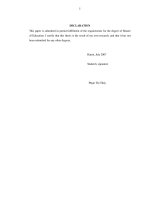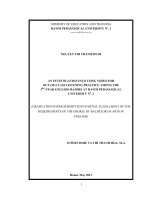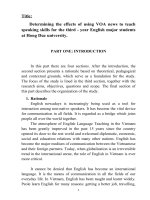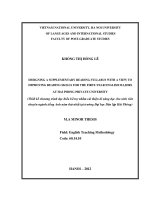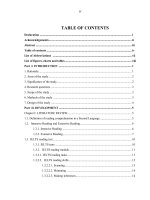Using mind maps to enhance reading comprehension of the third year english majors at thu dau mot university m a 60 14 10
Bạn đang xem bản rút gọn của tài liệu. Xem và tải ngay bản đầy đủ của tài liệu tại đây (36.1 MB, 127 trang )
VIETNAM NATIONAL UNIVERSITY – HCM CITY
UNIVERSITY OF SOCIAL SCIENCES & HUMANITIES
FACULTY OF ENGLISH LINGUISTICS AND LITERATURE
USING MIND MAPS TO ENHANCE READING
COMPREHENSION OF THE THIRD-YEAR
ENGLISH MAJORS
AT THU DAU MOT UNIVERSITY
Submitted to the
Faculty of English Linguistics & Literature
in partial fulfillment of the Master’s degree in TESOL
By
NGUYỄN THỊ PHƯỚC BÌNH
Supervised by
LÊ HUY LỘC, M.A.
HO CHI MINH CITY - AUGUST 2011
ACKNOWLEDGEMENT
I would like to express my deepest gratitude to my thesis supervisor, Mr Lê
Huy Lộc, MA., for his insightful discussions, constructive criticism, valuable
comments, and continuing support in the preparation and completion of this thesis.
I am greatly indebted to all the lecturers of the TESOL graduate program at
the University of Social Science and Humanities for their dedication and helpful
instruction during the course from the year 2007 to 2010
I would like to thank the teaching staff of Thủ Dầu Một university, Dr. Lý
Quyết Tiến, the Dean of Department of Foreign Languages, Ms Tào Thụy Khê,
MA., Mr Vo Duy Minh, without their assistance this thesis would not have been
possible.
Further I would like to extend my thanks to my students at Thu Dau Mot
University, who have participated in the study.
Last but not least, my deepest gratitude and special thanks are sent to my
parents, my brother, my sister, my husband and especially my lovely children, who
cared, encouraged, supported, and motivated me greatly during the time of
completing this study.
STATEMENT OF ORIGINALITY
I hereby certify my authorship of the thesis submitted today entitled:
USING MIND MAPS TO ENHANCE READING
COMPREHENSION OF THE THIRD-YEAR
ENGLISH MAJORS
AT THU DAU MOT UNIVERSITY
In terms of statement of Requirements for Theses in Master’s Program
issued by Higher Degree Committee.
Ho Chi Minh City, August 2011
NGUYỄN THỊ PHƯỚC BÌNH
ii
RETENTION AND USE OF THE THESIS
I, NGUYỄN THỊ PHƯỚC BÌNH, hereby state that I being the candidate for
the degree of Master in T.E.S.O.L. accept the requirements of the University
relating to the retention and use of Master’s theses deposited in the Library.
In terms of these conditions, I agree that the original of my thesis deposited in
the Library should be accessible for purposes of study and research, in
accordance with the normal conditions established by the Library for the care,
loan or reproduction of the theses.
Ho Chi Minh City, August 2011
NGUYỄN THỊ PHƯỚC BÌNH
iii
LIST OF OBSERVERS
1. Tào thị Thụy Khê, MA in TESOL
2. Nguyễn Ánh Ngọc, MA in TESOL
3. Nguyễn Quốc Việt, MA in TESOL
4. Trần Thị Ánh, MA in TESOL
iv
LIST OF FIGURES & TABLES
Figure 1.1: Mind map of “mind map” guidelines .................................................. 5
Figure 2.1: A spider-gram sample (extracted from Tipper, 2011) .......................... 18
Figure 2.2: A sample of outlining ......................................................................... 20
Figure 2.3: Conceptual framework ........................................................................ 22
Figure 2.4: A concept map showing the key features of concept maps ................. 26
Figure 4.1: The pattern of students’ responses to Item 1 of the questionnaire ........ 53
Figure 4.2: The pattern of students’ responses to Item 2 of the questionnaire ........ 53
Figure 4.3: The pattern of students’ responses to Item 3 of the questionnaire ........ 54
Figure 4.4: The pattern of students’ responses to Item 4 of the questionnaire ........ 55
Figure 4.5: The pattern of students’ responses to Item 5 of the questionnaire ....... 56
Figure 4.6: The pattern of students’ responses to Item 6 of the questionnaire ....... 57
Figure 4.7: The pattern of students’ responses to Item 7 of the questionnaire ....... 58
Figure 4.8: The pattern of students’ responses to Item 8 of the questionnaire ....... 59
Figure 4.9: The pattern of students’ responses to Item 9 of the questionnaire ....... 60
Figure 4.10: The pattern of students’ responses to Item 10 of the questionnaire ... 61
Figure 4.11: The pattern of students’ responses to Item 11 of the questionnaire ... 62
Figure 4.12: The pattern of students’ responses to Item 12 of the questionnaire ... 63
Figure 4.13: The pattern of students’ responses to Item 13 of the questionnaire ... 64
Table 4.1: Teacher’s observation on students’ attention to mind maps ................. 65
Table 4.2: Teacher’s observation on students’ ability to use mind maps ............... 66
Table 4.3: Descriptive statistics for the pretest and posttest .................................. 68
Table 4.4: The paired t-test’s results ............................................................... .... 69
v
TABLE OF CONTENT
Acknowledgement ........................................................................................... i
Certificate of Originality .................................................................................. ii
Retention and Use of the Thesis ...................................................................... iii
List of Observers ............................................................................................. iv
List of Figures and Tables ............................................................................... v
Table of Content .............................................................................................. vi
Abstract
....................................................................................................... x
CHAPTER 1 – INTRODUCTION ............................................................... 1
1.1. Background to the study ........................................................................... 1
1.1.1. The current teaching reading comprehension at Thủ Dầu Một
University ..................................................................................... 2
1.1.2. The use of mind maps to teach reading comprehension .................... 4
1.1.2.1. Mind maps introduction .......................................................... 4
1.1.2.2. The advantages and disadvantages of using mind maps in
learning activities ................................................................... 6
1.2. Purposes of the study ................................................................................ 8
1.3. Research questions ................................................................................... 9
1.4. Significance of the study ........................................................................... 9
1.5. Delimitation of the study .......................................................................... 10
1.6. Definition of terms ................................................................................... 10
1.7. The organization of the study .................................................................... 11
CHAPTER 2 - LITERATURE REVIEW .................................................... 12
2.1. Summarizing texts .................................................................................... 12
2.1.1. Summarizing texts overview ............................................................ 12
2.1.2. Theories of summarizing texts ......................................................... 13
vi
2.1.3. Summarizing texts in reading comprehension .................................. 15
2.1.4. Techniques of summarizing texts ..................................................... 17
2.1.4.1. Using spider-gram ................................................................... 18
2.14.2. Taking notes ............................................................................. 19
2.1.4.3. Outlining ................................................................................. 19
2.1.4.4. Highlighting ............................................................................ 21
2.1.4.5. Visualizing .............................................................................. 22
2.2. The use of mind maps ............................................................................... 23
2.2.1. Mind maps overview ........................................................................ 23
2.2.2. Differences between mind mapping and concept mapping ............... 25
2.2.3. Theories of “mind maps” perception ................................................ 27
2.2.3.1. Schema theory ......................................................................... 27
2.2.3.2. Radiant thinking ...................................................................... 28
2.2.3.3. Researches into the left and right hemispheres ........................ 28
2.2.3.4. The power of images ............................................................... 29
2.2.4. Advantages of using mind maps in summarizing texts ..................... 31
2.2.5. Prior studies with mind maps ........................................................... 32
2.3. Summary .................................................................................................. 36
CHAPTER 3 - RESEARCH METHODS ..................................................... 37
3.1. The Research design ................................................................................. 37
3.2. Participants in the study ............................................................................ 38
3.2.1. Students ........................................................................................... 38
3.2.2. Observers ......................................................................................... 38
3.2.3. The researcher’s role ........................................................................ 39
3.3. Instrumentation ......................................................................................... 39
3.3.1. The use of mind maps ...................................................................... 39
3.3.1.1. Introducing mind maps ............................................................ 40
3.3.1.2. Activities using mind maps ..................................................... 40
vii
3.3.2. Questionnaire ................................................................................... 41
3.3.3. Observation ..................................................................................... 42
3.3.3.1. Teacher observation ................................................................ 43
3.3.3.2. Team observation .................................................................... 43
3.3.3.3. Observation sheet and instructions .......................................... 43
3.3.4. The one group pretest-posttest design .............................................. 44
3.3.4.1. The pretest .............................................................................. 44
3.3.4.2. The posttest ............................................................................. 45
3.3.4.3. Paired t-test & Critical α value ................................................ 46
3.3.4.3.1. Paired t-test .................................................................... 46
3.3.4.3.2. Critical α value ............................................................... 46
3.4. Variables .................................................................................................. 47
3.4.1. Independent variable ........................................................................ 47
3.4.2. Dependent variables ......................................................................... 47
3.4. Research procedures ................................................................................. 47
3.6. Methods of data analysis ........................................................................... 48
3.7. Materials ................................................................................................... 49
3.8. Limitations of the study ............................................................................ 50
3.9. Summary .................................................................................................. 51
CHAPTER 4 - DATA ANALYSIS & FINDINGS ....................................... 52
4.1. Data analysis ............................................................................................ 52
4.1.1. Questionnaire ................................................................................... 52
4.1.1.1. Item 1 ...................................................................................... 52
4.1.1.2. Item 2 ...................................................................................... 53
4.1.1.3. Item 3 ...................................................................................... 54
4.1.1.4. Item 4 ...................................................................................... 55
4.1.1.5. Item 5 ...................................................................................... 56
4.1.1.6. Item 6 ...................................................................................... 57
viii
4.1.1.7. Item 7 ...................................................................................... 58
4.1.1.8. Item 8 ...................................................................................... 59
4.1.1.9. Item 9 ...................................................................................... 60
4.1.1.10. Item 10 .................................................................................. 61
4.1.1.11. Item 11 .................................................................................. 62
4.1.1.12. Item 12 .................................................................................. 62
4.1.1.13. Item 13 .................................................................................. 63
4.1.2. Observation activities ....................................................................... 64
4.1.2.1. Teacher observation ................................................................ 65
4.1.2.2. Team observation .................................................................... 66
4.1.3. One group pretest-posttest design ..................................................... 66
4.1.3.1. Descriptive statistics ................................................................ 66
4.1.3.2. Paired t-test ............................................................................. 67
4.2. Findings .................................................................................................... 68
4.3. Summary .................................................................................................. 74
CHAPTER 5 – CONCLUSION, IMPLICATIONS & RECOMMENDATIONS
5.1. Conclusion ................................................................................................ 75
5.2. Implications ............................................................................................... 76
5.3. Recommendations .................................................................................... 79
Bibliography .................................................................................................... 80
Appendix 1 – Questionnaire (English and Vietnamese versions) ..................... 90
Appendix 2 – Observation Sheet & Instructions .............................................. 96
Appendix 3 – Mind maps Introduction ............................................................ 99
Appendix 4 – Pretest ....................................................................................... 103
Appendix 5 – Posttest ...................................................................................... 112
Appendix 6 – Some pictures from the reading classes …………………………116
ix
ABSTRACT
This study was designed to improve students’ reading comprehension by
suggesting students using the innovation of mind maps in summarizing the texts
learned. The study aimed to study attitudes towards the use of mind maps of thirdyear English major students at Thủ Dầu Một University and to investigate these
students’ improvement on their reading comprehension after over three months
using mind maps in summarizing the texts learned.
The study employed a combination of research design, consisting of a
questionnaire, the class observation and an experimental design of One-group
Pretest-Posttest. The subjects of the study were sixty third-year English major
students at Thủ Dầu Một University for the 2009-2010 academic year. The
questionnaire and the class observation were used for consider students’ attitudes
towards the use of mind maps. A paired t-test was used for judging if the difference
between the means of the pretest and the posttest relative to the spread of the scores
was statistically significant.
The findings show that students in the study highly appreciated the use of
mind maps, and they were motivated by this innovation to apply it into their learning
activities. As a result, these students’ reading comprehension improved remarkable
at the end of the study when the posttest was held. The paired t-test judged the
difference between the means of the pretest and the posttest of the subject was
extremely statistically significant.
Based on the findings, the study made some suggestions for improving
students’ reading ability. The first is that teachers should suggest students focusing
on the activity of summarizing. The second is that students should be encouraged
using mind maps in summarizing when this innovation is completely appropriate to
the operation mechanism of human beings’ brain.
x
CHAPTER 1
INTRODUCTION
This thesis reports the study on the use of mind maps in teaching reading
comprehension. This study was done with 60 third-year students of English majors
at Thủ Dầu Một University. The study aimed to investigate the influence of using
mind maps on the students. The study also aimed to examine their improvement on
reading comprehension after the experimental teaching.
1.1. BACKGROUND TO THE STUDY
Reading is one of the two receptive skills. It is an interactive process between
the reader and the text, resulting in comprehension. The text presents letters, words,
sentences, and paragraphs that code meanings. Readers use knowledge, skills, and
strategies to determine the meanings that the texts convey. It is the process of
reading comprehension. Reading comprehension, according to Burt, Peyton &
Duzer (2005), is the ability to encode the written texts, making the texts meaningful.
These authors gave some suggestions for teaching reading comprehension. They are:
• Have students complete cloze passages (in which learners fill in specific
words that are left out of a text).
• Provide instruction in comprehension strategies such as using headings and
graphics to predict meaning, summarizing verbally, skimming, and scanning.
• Assess students’ strategy use by asking them which comprehension
strategies they used.
• Assess learners’ reading comprehension by having them read passages and
answer comprehension questions about the text in multiple choice or short
answers.
1
• Have students summarize readings.
Burt, Peyton & Duzer, (2005)
As the suggestions state, students are advised comprehension strategies such
as using heading and graphic to predict meaning, summarizing, shimming and
scanning. Skilled readers are purposeful, active and apply comprehension strategies
to the text. Dolence & Norris (1995) has claimed that society and individual learners
now have different needs in terms of what learners need to learn and how they can
and should learn. The National Research Council of the United States of America
(2000) pinpointed that the goal of education has shifted from an emphasis on
comprehensive coverage of subject master to helping the students develop their own
intellectual tool and learning strategies. Because of this change, the roles of the
education nowadays become more challenged. This means that the learners should
have appropriate approaches to the receptive skills to become successful in learning
(Krashen & Terreil, 1983; Larsen-Freeman, 1986).
Therefore, it is believed that when a reader equips him/herself with tactful
skills and appropriate strategies, his/her reading comprehension will be improved
significantly (Nunan, 1995; Nunan, 1999; Harmer, 1998).
1.1.1. The current teaching reading comprehension at Thủ Dầu Một
University
Reading is one of the essential skills taught at the Department of Foreign
Languages at Thủ Dầu Một University. At Thủ Dầu Một University, half of the
students are trained to be teachers in secondary high-schools after graduating from
the university. In the third year, these students are required to work more objectively
and creatively on the four skills of using English and some other subjects such as
translation, literature and methodology. So they only study reading for 22 hours with
2
the course book of Interactions 2 Reading, silver edition by the same writers and
publisher, published in 2007.
For many years, third-year English major students at Thủ Dầu Một University
have been largely taught by the traditional teaching method which has been stable
from years to years. This teaching method has been done by asking students
questions following reading activities or by assigning skill sheets as practice for
reading comprehension skills. These activities usually ask students to give the main
idea of the texts learned, to determine the sequence of sentences, to note the details
in the texts, and to give the cause and affect relationships that they can pick out from
the texts learned. However, such a way of teaching reading comprehension has been
more or less focused on the product rather than on the process of learning.
Furthermore, students today differ from students in the past. Sousa (1988) wrote,
“Yesterday’s method worked well for yesterday’s students. However, the student
brain of today is quite different from the one of fifteen years ago." For example,
“today’s children spend much more time with television and other electronic media
than with their parents” (Sousa, 1988). Reading is an activity with purposes and
purposes for reading determines the appropriate approach to reading comprehension.
Simply asking students to respond to a worksheet or to answer a list of
comprehension questions does nothing to develop new comprehension skills
because worksheets, in reality, are nothing more than informal tests. It is obvious
that reading comprehension improves when teachers provide explicit comprehension
strategy instructions. When students are provided with instructional activities that
support their understanding of the texts, they will read better (Nunan, 1995; Nunan,
1999; Harmer, 1998).
From the previous experience, the researcher believes that summarizing a
reading text can help the readers understand it better, and “mind map” is one of the
good ways to summarize the reading texts.
3
1.1.2. The use of Mind Maps to teach reading comprehension
1.1.2.1. Mind Maps introduction
Buzan (1984) has recommended a way to summarize the reading texts, which
named “mind maps." According to Buzan (1984), the nature of mind maps is an
intimately connected with the function of the mind, and they can be used in nearly
every activity including taking notes when summarizing the reading texts (Buzan,
1984, p. 112). Biktimirov & Nilson (2003) defined mind mapping (or “idea”
mapping) as “visual, non-linear representations of ideas and their relationships.”
Mind maps comprise a network of connected and related concepts. However, in
mind mapping, any idea can be connected to any other. Free-form, spontaneous
thinking is required when creating a mind map and the aim of mind mapping is to
find creative associations between ideas. Thus, mind maps are principally
association map (Davies, 2010, p. 3).
A mind map is a highly effective way of getting information in, and out of
your brain - it is a creative and logical means of note-taking and note-making that
literally "maps out" your ideas (Buzan & Buzan, 2000). All mind maps have some
things in common. They have a natural organizational structure that radiates from
the center and use lines, symbols, words, color and images according to simple,
brain-friendly concepts. Mind mapping techniques involve using line thicknesses,
colors, pictures and diagrams to aid knowledge recollection (Davies, 2010). A mind
map converts a long list of monotonous information into a colorful, memorable and
highly organized diagram that works in line with your brain's natural way of doing
things. One simple way to understand a mind map is comparing it to a map of a city.
The city center represents the main idea; the main roads leading from the center
represent the key thoughts in your thinking process; the secondary roads or branches
represent your secondary thoughts, and so on. Special images or shapes can
represent landmarks of interest or particularly relevant ideas.
4
Figure 1.1: Mind map of “mind map” guidelines
[Source: />
Mind map, to certain extent, is the process of converting a mass of data,
information; ideas into a graphic map give the student an increased understanding
and insight into the topic at hand. To create mind map, the student must concentrate
on the relationships between the items and examine the meanings attached to each of
them. While creating a map, the student must also prioritize the information,
determining which parts of the material are the most important and should be
focused upon, and where each item should be placed in the map. The creation of
graphic organizers also helps the student generate ideas as they develop and note
their thoughts visually. The possibilities associated with a topic become clearer as
the student's ideas are classified visually. Doing mind mapping, readers place an
image at the center of a note page and then branch out in an organized fashion
around the image using key words and key images to help them concentrate and
memorize. As the mind map is built up, readers’ brain creates an organized and
integrated total map of the intellectual territory that is explored as it can be seen in
Figure 1.1 above.
5
Thus, mind map is the external mirror of your own radiant or natural thinking
facilitated by a powerful graphic process, which provides the universal key to
unlock the dynamic potential of the brain.
1.1.2.2. The advantages and disadvantages of using mind maps in
learning activities
Mind mapping is a skill that cuts across ability levels and encompasses all
subject matters (Goldberg, 2004). Tipper (2011) discussed Buzan gathered all of the
best practice of other techniques that he could find and combined them into what he
later called the “mind map”. Ruffini (2008) gave the idea that using the mind map
technique gives instructors the freedom to express ideas and show interrelationships
between concepts and content in a very visual and nonlinear structure that benefits
their students (Ruffini, 2008).
The main use of mind mapping is to create an association of ideas (Davies,
2010, p. 5). However, another use of is for memory retention – even if the
advantages in the case of mind mapping might be marginal (Farrant, Hussain &
Hennessy, 2002). It is generally easier to remember a diagram than to remember a
description. With such memory retention – in other words, vocabulary retention –
students’ ability of reading comprehension will be improved.
Discussed the benefits of mind maps, Lewis (2011) listed as follows:
The flexibility of mind maps to help us think divergently and convergently
and visualize our thinking means that they are, when used properly, an
essential part of our intellectual armory.
Mind maps are an ideal tool for understanding inter-relationships between
different aspects of a situation; by focusing on meaning rather than worrying
about grammar and semantics, mind maps help people to rapidly build up an
enhanced understanding of any problem, challenge or situation.
6
Often combined with speed reading and advanced overview techniques, mind
maps allow us to summarize information efficiently and in such a way as to
make it usable and accessible.
The key is to think effectively at the beginning of a project or the preparation
of a presentation. Suspending the process of structuring an output (project
plan, presentation) allows maximum value to be gained from the divergent
and associative thinking that mind maps support so well.
A great deal of stress is caused by not being able to see clearly a way
forward. Many people use mind maps to help them make sense of the
different aspects of their lives and prioritize their goals going forward.
Either on their own or with other creativity techniques, mind maps facilitate
the generation of fresh perspectives and new ideas provide a great way of
capturing that thinking - especially if you make use of the excellent mind
mapping software that is now available.
Schools, Universities and Business Schools are amongst the many
organizations that have recognized that, when used properly, mind maps are
an incredibly useful tool for both formal and informal learning.
(extracted from Lewis, 2011)
A disadvantage of mind mapping is that the types of links being made are
limited to simple associations. Absence of clear links between ideas is a constraint.
Mind maps have been said to be idiosyncratic in terms of their design, often hard for
others to read; representing only hierarchical relationships (in radial form);
inconsistent in terms of level of detail; and often too complex and missing the “big
picture” (Eppler 2006; Zeilik, 2010). Those people who are very logical and do not
tend to trust their intuitive side will initially find it difficult to trust the technique,
because their logic is telling them that this different way of working is impossible
7
(Courseware, 2011). However, the habit of utilizing the brain’s multi-processing
capabilities in this way starts to develop after the first half-a-dozen or so attempts
and so anyone can do it with a little perseverance.
Another disadvantage of mind mapping is that the technique provides a
structured way for recording information and therefore they are not suitable for
recording more chaotic forms of creative idea production like for example ideas
generated during brainstorming sessions (Courseware, 2011). In this case mind
maps would inhibit idea production through the effort of the participants to associate
and structure their ideas on paper. Furthermore, mind maps intrigues people who are
not the creator of the relevant mind maps. A mind map provides a self explanatory
presentation of information and structure only to those participants who took part in
the creation of a mind map. This is because meaning and symbol use were
negotiated within the mind mapping group and participants developed a shared
understanding. This, however, do not mean anything to someone who did not take
part in the mind map creation (Courseware, 2011).
Mind mapping is also limited in dealing with more complex relationships
(Davies, 2010). This technique might be useful to brainstorm the things that are
critical for students to recall in an exam (or a presentation, as in the example
provided). However, it is hard to see it being useful for a purpose that requires an
understanding of how one concept is essential to understanding another (Davies,
2010). Davies (2010) suggested using another technique when more than one
concepts relevant to the case. That is concept mapping, of which the differences
with mind mapping will be discussed in the next chapter, section 2.2.2.
1.2. PURPOSES OF THE STUDY
This study purposed to discover the effects that the use of mind maps has on
third-year English major students at Thủ Dầu Một University. The intervention was
8
expected to provide these students with the technique of using mind maps to
summarize reading texts. This summarization was done in such a way that these
students made a map, something like a road map, with key words to help them
remember the texts learned.
Upon the mentioned purpose, one of the study objectives is to study the way
that students in the study practiced summarizing after being introduced the
technique to learn reading comprehension with mind maps. The study also aimed to
examine if the intervention of mind maps helped these students improve their
reading comprehension after attending the course.
1.3. RESEARCH QUESTIONS
The study was done to answer the two following research questions:
1. How have students summarized the main ideas of reading texts before
approaching mind maps?
2. To what extent do mind maps help them summarize the main ideas and
enhance their reading comprehension?
1.4. SIGNIFICANCE OF THE STUDY
The study gives us an insight into the ways that human brains perceive
language through maps and key words. To be able to keep texts in our brain, we do
not simply translate it from a second language to our mother tongue. Appropriate
strategies, which are based on theories of perceiving texts, should be applied for
students to apply when learning reading comprehension.
Furthermore, the study gives us a correlation between students’ ability to
summarize genres learned and their reading comprehension. The study proves that
when a student is able to summarize a text, he/she will possess a good ability of
reading comprehension.
9
This study also introduces an innovation in teaching reading comprehension.
The current teaching method, which has been based largely on Grammar-Translation
method, clearly does not motivate students to learn hard reading comprehension.
Students today are not similar to students in the past, as Sousa (1988) mentioned.
Therefore, innovations should be applied to motivate these students. In such a way,
this study is a feedback for the current method of our teaching reading
comprehension.
1.5. DELIMITATION OF THE STUDY
This study confined itself to the reading skill of third-year English major
students at Thủ Dầu Một University. These students are believed to be teachers of
the subject of English when they graduate from the university. These students, in
general, have more than five years of learning English.
This study also confined itself to the summarizing activities of the course.
Students in the study were advised to ignore other techniques of summarizing texts
as taking note, using spider-grams, outlining or highlighting to focus on using mind
maps to summarize texts. Students also were encouraged using this technique when
doing their learning activities at home.
The last delimitation of the study relates to the texts used in the course. These
texts were extracted from the course book of Interactions 2 Reading by Pamela
Hartmann and Elaine Kirn published by Mc Graw Hill in 2007. The students work
on the first five chapters with the topics: Education & student life, City life,
Business & money, Jobs & professions, Lifestyles around the world.
1.6. DEFINITION OF TERMS
In this study, the following terms should be understood as they are defined as
follows:
10
- The term summary and its derived words are defined as a map with a center word
and its branches with key words. Figure 1.1 on page 5 displays the typical map.
- The term Mind Map should be understood as it will be defined in the next chapter,
section 2.1.
- The term reading comprehension is narrowed to the reading ability of third-year
English major students at Thủ Dầu Một University. These students are able to read
intermediate level reading materials.
Other terms are understood as normally.
1.7. THE ORGANIZATION OF THE STUDY
The study consists of five chapters:
Chapter One presents an introduction to the study consisting of: the
significance of the study, the research questions, the hypotheses, the research
methodology, the scope of the study and the organization of the study.
Chapter Two presents a review of the literature relevant to the study.
Chapter Three describes the methodology that is used to carry out the
research.
Chapter Four discusses the data analysis and its findings.
Chapter Five presents conclusions and recommendations for further research.
11
CHAPTER 2
LITERATURE REVIEW
This chapter reviews the literature relevant to the aspects on which the study
focuses. In this chapter, the aspects of the summarizing texts and its roles in
students’ reading comprehension, the use of mind maps and its advantages in
students’ reading comprehension will be discussed. This chapter also reviews the
results of prior studies on the field of applying images into teaching reading
comprehension to give in-depth information about the aspects.
2.1. SUMMARIZING TEXTS
2.1.1. Summarizing texts overview
Summarizing texts is telling the main ideas or events of a story in someone’s
own words. A good summary includes setting, main characters, problem, and
resolution. Keene & Zimmerman (1997) claimed that a summary is a list of the parts
and synthesis is somehow the creation of a whole. It requires real creative, critical
thought. It should go on throughout the process of reading, not just as the end
(Keene & Zimmerman, 1997, p. 173). This activity is the process of identifying,
recording, and writing the most important information from a text into one’s own
words. Hovy (2003) defined a summary as a text that is produced from one or more
texts, that contains a significant portion of the information in the original text(s),
and that is no longer than half of the original text(s) (Hovy, 2003, p. 584). Thus,
Hovy (2011) discussed, to be a summary, the summary must obey two requirements:
[1] it must be shorter than the original input text; and [2] it must contain the
important information of the original text (where importance is defined by the user),
and not other, totally new, information (Hovy, 2003, p. 593). The main goal of a
summary is at all to present the main ideas in a document in less space. If all
12
sentences in a text document were of equal importance, producing a summary would
not be very effective, as any reduction in the size of a document would carry a
proportional decrease in its informativeness. Luckily, information content in a
document appears in bursts, and one can therefore distinguish between more and
fewer informative segments. Identifying the informative segments at the expense of
the rest is the main challenge in summarization (Radev, Hovy & McKeown, 2002, p.
399). Summarizing, then, helps readers focus on the most important ideas in reading
texts.
Summarizing texts is a strategy that many students have difficulty with.
Identifying the main events or ideas in a story is something that good readers also
do. They are constantly pulling out ideas from the text they are reading and
determining what the main points are in each segment of the reading passage. In
addition, they have an ability to recognize and discuss key events in a story. Irwin
and Baker (1989) argued that skilled readers have an ability to select the information
they will need in order to understand the reading passage. Further, these readers also
have the ability to ignore information that is not important. In other words,
summarizing is telling the main ideas or events of a story in one’s own words,
restating of the main ideas of the text in as few words as possible (Marzano,
Pickering & Pollock, 2001).
2.1.2. Theories of summarizing texts
Summarizing has a robust and long history of research (Marzano, Pickering
& Pollock, 2001, p. 30). Anderson & Hidi (1987; 1998/1999) attracted three
generalizations from these researches:
1. To effectively summarizing, students must delete some information,
substitute some information, and keep some information. This generalization springs
from the work of cognitive psychologists like Walter Kintsch and Teun van Dijk
(Marzano, Pickering & Pollock, 2001, p. 30). These psychologists have studied the
13
basic cognitive mechanisms involved in summarizing to come to this generation.
According to these psychologists, when a student reads a passage with the purpose
of summarizing it, his/her mind will quite naturally engage in three activities: [1]
deleting things, [2] substituting things, and [3] keeping things. This synthesis of the
information is technically referred as the “macro-structure” of the information.
According to Marzano, Pickering & Pollock, students who can effectively
summarize learn to synthesize information, a higher-order thinking skill which
includes analyzing information, identifying key concepts, and defining extraneous
information (Marzano, Pickering & Pollock, 2001)
2. To effectively delete, substitute, and keep information, students must
analyze the information at a fairly deep level (Marzano, Pickering & Pollock, 2001,
p. 31). Rosenshine, Meyer, and Chapman (as cited in Marzano, Pickering & Pollock,
2001), concluded that strategies that emphasize the analytic aspect of summarizing,
produce the most powerful effects in terms of students’ ability of summarizing.
Students have to analyze information at a deep level in order to decide what
information to delete, what to substitute, and what to keep when they are asked to
give a summary (Anderson, V. & Hidi, 1988/1989; Hidi & Anderson, 1987, as cited
in Marzano, Pickering & Pollock, 2001)
3. Being aware of the explicit structure of information is an aid to
summarizing. This generalization was brought to the attention of educators by the
work of psychologists like Bonnie Meyer (Marzano, Pickering & Pollock, 2001, p.
32). These researchers have observed that the more a person is aware of the explicit
structure of a text, the better he/she is able to summarize the information (Marzano,
Pickering & Pollock, 2001, p. 32). In general, researchers have demonstrated that
making students aware of the specific structure in information helps them
summarize that information. To illustrate, assume a student is about to read the text
14



